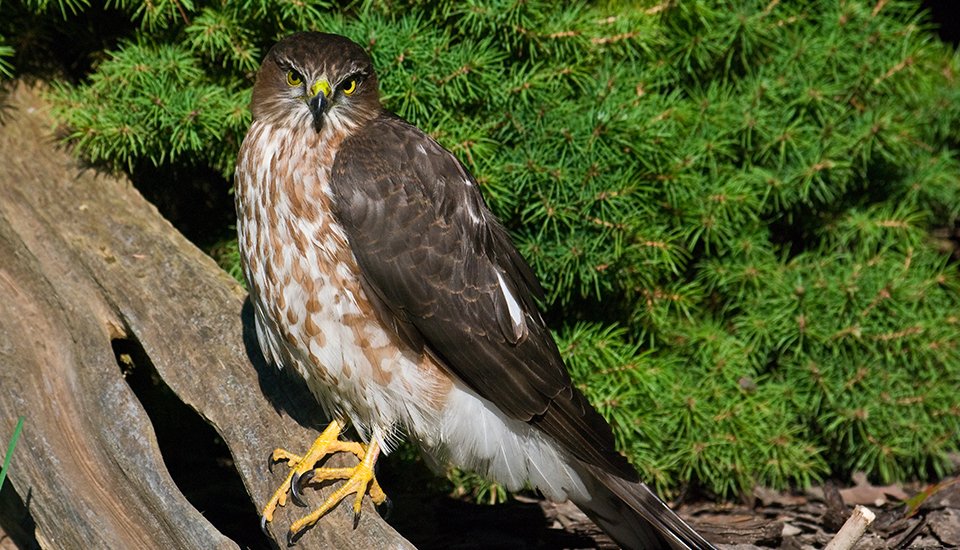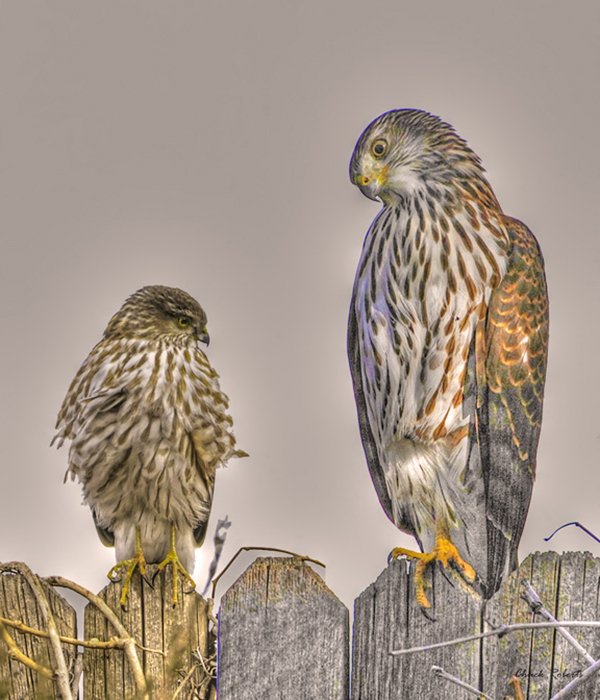Sharpie or Coop?

“I’m not sure.”
Naturespixel, Shutterstock.
The three closely related accipiter species are, from smallest to largest, Sharp-shinned Hawk, Cooper’s Hawk, and Northern Goshawk. If you see an accipiter in the Seattle area, you’re almost certainly looking at a “Coop” or a Sharpie”, because goshawks are rare in U.S. cities.
For more information
Dunne, P., Sibley, D., & Sutton, C. 2012. Telling accipiters apart. Hawks in Flight. Second edition. Houghton Mifflin Harcourt.
Kaufman, K. 2011. Field Guide to Advanced Birding. Houghton Mifflin Harcourt.
Ligouri, J. 2005. Hawks From Every Angle. Princeton University Press.
Cooper’s Hawks and Sharp-shinned Hawks are often hard to tell apart in the field. Here are some basics to consider.
Likelihood of Occurrence
- Although both Cooper’s and Sharp-shinned hawks occur regularly in Seattle, Cooper’s Hawks are far more common. Many Coops breed in both the city and the suburbs. A few Sharpies breed in the suburbs.
- Cooper’s Hawks are around Seattle all year. Sharp-shinned Hawks are winter residents, arriving in early fall and leaving in early spring.
Size
Crow-sized accipiters are probably Coops, and robin-sized ones are probably Sharpies. However, this distinction is not always so obvious:
- As in most raptor species, females are larger than males. A large female Sharpie can look similar to a small male Coop.
- A large juvenile female Cooper’s Hawk may be mistaken for a similarly plumaged juvenile goshawk—but remember, goshawks are rare in Seattle.

Composite of juvenile Sharp-shinned and Cooper’s hawks photographed on the same fence (2″ pickets) at different times. Left: probably a male Sharp-shinned Hawk. Right: probably a female Cooper’s Hawk. Chuck Roberts, Flickr.
Field Marks
Besides size, a number of field marks help to distinguish between Coops and Sharpies. Some are subtle, and all are well described elsewhere.
Four obvious field marks for most observers are:
Tarsus size
Coop tarsi, commonly called legs, are pencil-sized, and those of Sharpies are matchstick-sized. This difference is easiest to view in perched birds.
Head and nape feathers
In adults, Coops have a dark cap and pale nape (“Cooper’s cap”), while Sharpies have a solid dark crown and back (“Sharpie’s solid”).
Head shape
When perched, Cooper’s Hawks may show raised hackles, making the head look large and square. Sharpie heads are rounded.
Tail tip shape
When viewed in flight, Cooper’s Hawks typically have a rounded tail tip and Sharpies typically have a square tail tip. In perched birds, get a good view of the folded tail from the front, and you’ll see that the outer tail feathers are shorter in Coops. However, both Sharpies and Coops can fly with their tail closed and then the square or round tail tip doesn’t apply.
BUT all accipiters except first-year birds molt in late summer and fall, which can alter tail shape—so this trait alone is not always a definitive field mark.
- Even with practice, accipiters may resist identification. Be comfortable with saying “I’m not sure.”